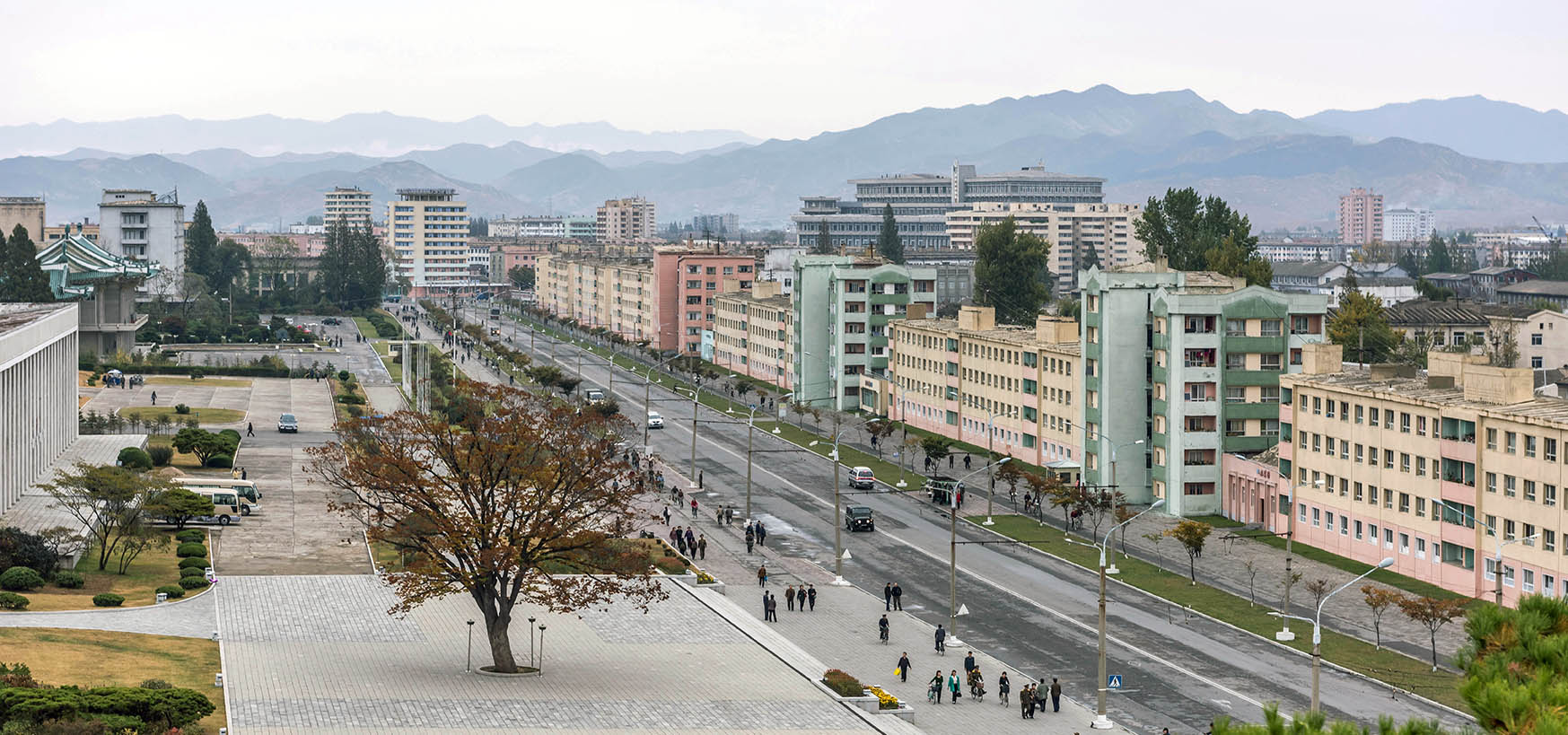This year, 2019, the Korean Society commemorates the centennial of the Korean provisional government and the March 1st Movement in 1919. As historical accounts resurface in the name of the centenary, I can sense how present this history continues to be. Over the past few years, the architectural world has held a series of events in celebration of this centennial of Modernist architecture: Adolf Loos’ Steiner House – considered the starting point of Modernism – was completed in 1910, De Stijl was founded in 1917, and Bauhaus was established in 1919. As such, an opportunity to review the Modernism movement has occurred.
The 2014 Venice Architecture Biennale celebrated the centenary of Le Corbusier’s Dom-Ino under the theme, ‘Absorbing Modernity: 1914 – 2014’. Under the direction of Rem Koolhaas, all participants covered the related topics. The Korean Pavilion demonstrated the Korean Peninsula as a single entity through the examination of both Korean architecture, drawing a huge amount of attention and winning the Golden Lion Award for the first time. The significance of the award can be examined from two positions. First, the world started to pay attention to the accomplishment of Korean architecture; the other – as noted by Cho Minsuk (principal, Mass Studies), the Director of the Korean Pavilion at that time – that Korea should in the modern era be treated as the ‘Korean Peninsula’ rather than dividing it into South/North. As an extension to Cho’s remarks, this article will narrate a fascinating story and raise a question: what present-day meaning will the Bauhaus – which spreads modern architecture to the whole world – present us with with regards to
the modernisation of the architecture of the Korean Peninsula?
Modernism and the Reconstruction of Cities in North Korea
The Korean War, erupting in 1950, was the biggest tragedy to befall the Korean Peninsula. From the standpoint of the North, however, it became a moment of reset and renovation by which to build a new socialist urban ideal. During the Korean War, it was estimated that the United States used 630,000 tons of bombs for bombardment only—this figure exceeds the overall amount of bombs (about 500,000 tons) dropped during World War II.▼1 This fact might reveal how much the cities in North Korea were ‘initialised’.
Thanks to this erasure of those remnants of the Joseon Dynasty and the Japanese occupation, the perfect opportunity was present for a new socialist city to be born. During the post-war reconstruction process, North Korea received aid from the socialist bloc, from the Soviet Union, Eastern Europe, and China. The Soviet Union and China gave aid competitively, funding 290 Million Rubles and 260 Million Rubles respectively,▼2 followed by support from East Germany, Poland, the Czech Republic, Romania, and Hungary.▼3 This aid did not only involve an economic aspect; the technology and culture of the communist world were also transferred into North Korea. The modernisation of North Korea had finally begun.
From the 1930s, under the oppression of the Nazis, the Bauhaus began to spread far out of Germany: Walter Gropius moved to the United States and found a home at Harvard University; Hannes Meyer moved to Russia and organised the Red Bauhaus Brigade. This also traveled and gave influenced to the Far East, North Korea. The ideas – functionalism, industrialisation of construction, manufacturisation – used by the Bauhaus spread its influence re-emerged in mainland Europe in the late 1940s, when the first generation of the Bauhaus had receded. Of the Eastern European socialist countries, the Bauhaus ideals – related to Marxism – were highlighted. This is because, while the construction of socialist cities was pushed forward in the decades following the 1930s, those efforts were accelerated during the post-war reconstruction process after World War II. North Korea also followed this wave, putting significant effort into building socially sensitive cities.
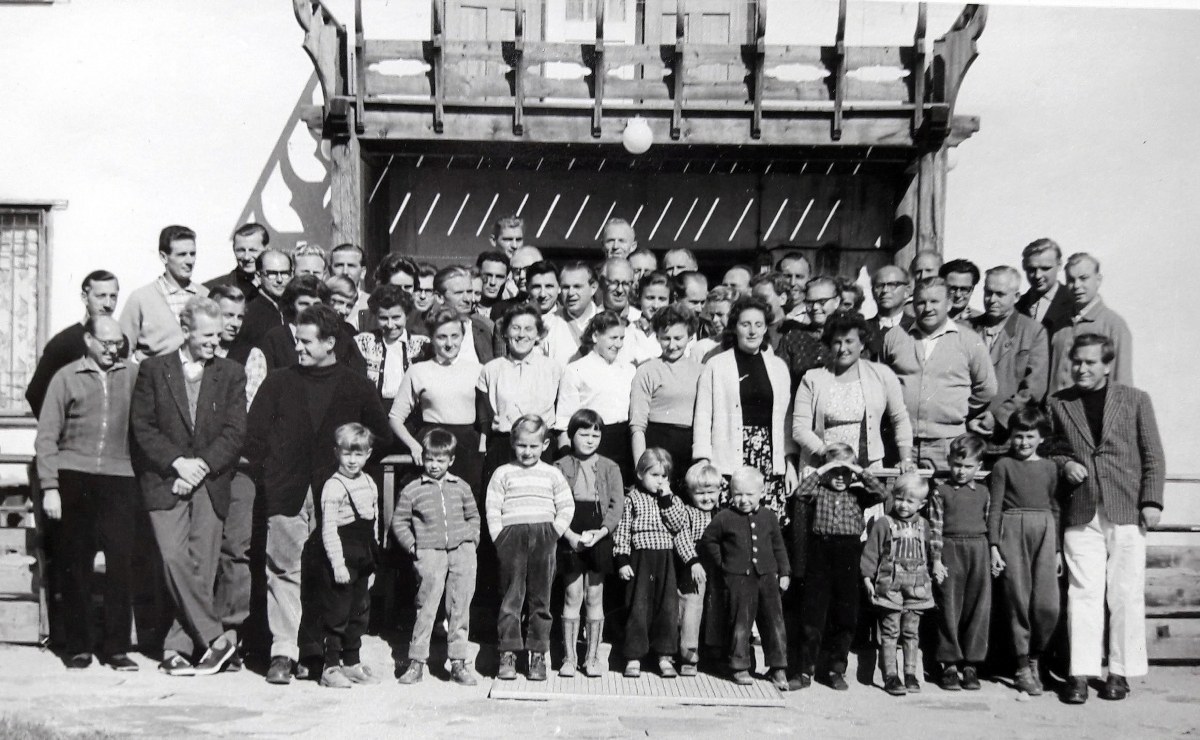
ⓒ Professor Matthias Schubert D 23968 Wismar Muschelring 17 / Wikimedia Commons
The Reconstruction of Hamhung and the Traces of the Bauhaus
As mentioned above, the socialist bloc helped North Korea during post-war reconstruction. Of these sponsors, the aid emanating from East Germany exceeded well beyond that of economic assistance. At the 1954 Geneva Conference, where the Korean Peninsula Peace Treaty was negotiated, the East German Prime Minister Otto Grotewohl was presumed to have mentioned the reconstruction of the North: the letter sent to Grotewohl by Kim Il Sung, said that Kim thanked the Prime Minister for his promise of reconstruction to the North delegation at the Geneva Conference, and also wished that East Germany might participate in the reconstruction of Hamhung.▼4 That was how the Hamhung reconstruction project of East Germany was initiated in earnest.
The reconstruction project was led by the German work group DAG (Deutsche Arbeitsgruppe Hamhung). The prime minister Grotewohl appointed his son Hans Grotewohl as the head of the DAG, which indicates how important this project was to him.▼5 Founded in 1955, DAG planned to oversee reconstruction for 10 years until 1964; yet, the project ended in 1962. Educated at the Bauhaus, Konrad Püschel was selected as the person in charge of city planning and entered North Korea with 175 members of DAG in 1955, executing the planning of Hamhung and Hungnam until 1959,▼6 after which his successor Karl Sommerer undertook the project.▼7 Let’s take a closer look at the city planning of Hamhung. In the ‘Comprehensive Construction Plan of the City of Hamhung’, which was led by Püschel, he seemed to suggest establishing an axis for city development – which is set perpendicular to the Songchon River – to encourage the city to expand beyond the river. This is similar to the plan for Pyongyang, which sets East Pyongyang on the opposite side of Daedong River, and promoting Pyongyang for development in balance along the Daedong River. However, unlike East Pyongyang, which was developed during 1960s post-war reconstruction, the area beyond the Songchon River in Hamhung barely changed during postwar reconstruction: the continuity of the urban fabric with the central area is still not clearly expressed.
Püschel’s plan can be understood when examining ‘Jongsong Street’, the main street in Hamhung. Jongsong Street was called Wilhelm Pieck Avenue, after the East German President, at the time of working on the planning. Püschel personally said the street resembled Berlin’s Stalinallee. In other words, the plan for Jongsong Street accommodates the concept that the major buildings and residential programmes should be placed along the street, expanding the city along with such re-routing. Currently, major buildings stand on the street: the South Hamgyong House of Culture (1960), the Museum of the Revolutionary Activities of Comrade Kim Il Sung (1972), and the Tonghungsan Haebang Pavilion. Statues of Kim Il Sung and Kim Jung Il are also in place. Of those major buildings, the South Hamgyong House of Culture is one of the few cultural facilities that was built based on the design of DAG. The Museum of the Revolutionary Activities of Comrade Kim Il Sung is also located to the right as indicated in the DAG’s construction plan. However, while the Jongsong street was set up to extend beyond the Manse-bridge of the Songchon River, the development of the urban fabric beyond the Mansebridge, as aforementioned, is barely recognisable.
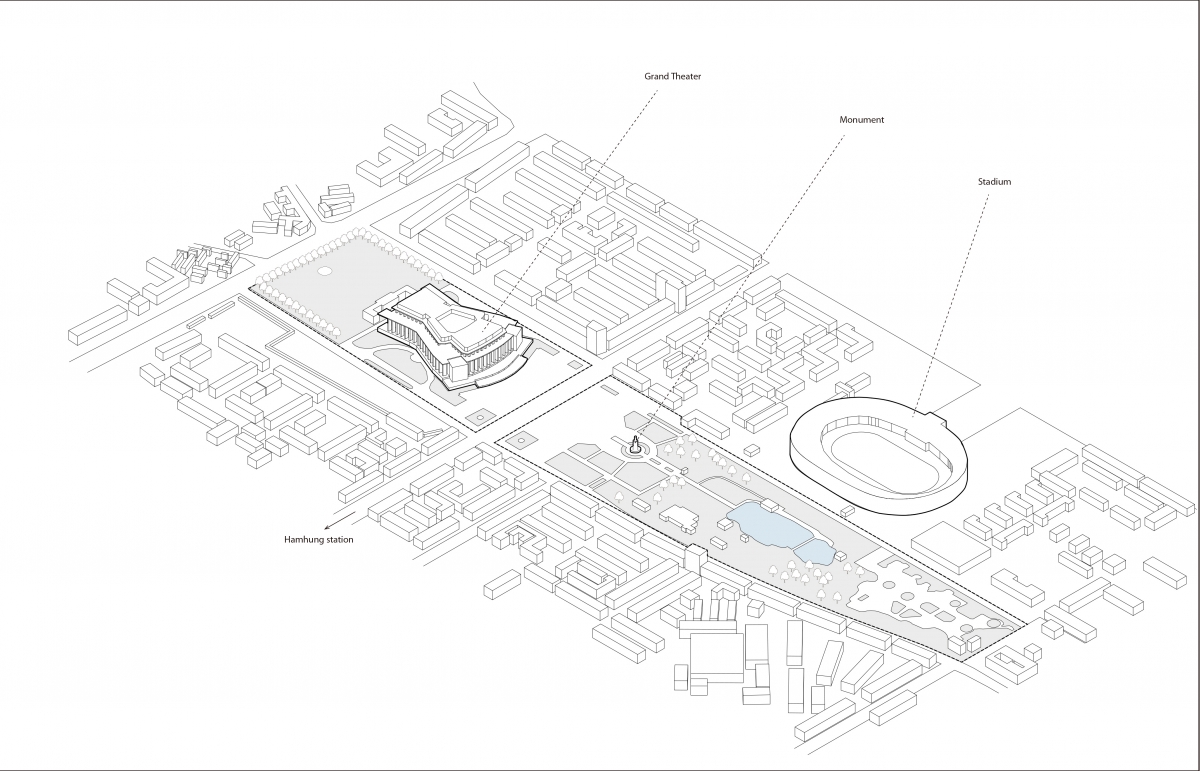
©PRAUD
The Bauhaus: Planning Hamhung Central Square
In Püschel’s plan, if the Wilhelm Pieck Avenue is considered Berlin’s Stalinallee, then the Central Square of Hamhung corresponds to the Alexanderplatz. Püschel kept the Alexanderplatz in mind and designed a clearer form for a Central Square in the ‘Comprehensive Construction Plan of the City of Hamhung’. His successor Karl Sommerer developed the details in the plan, asserting that housing, cultural facilities, and commerce should develop together in the Central Square, in order to show the eminence of socialism and the image of a modernised city.▼8
As Sommerer claimed, the square planned by DAG was a Central Square, not a Symbolic Square. In the ‘Tentative Plan to resolve major parts of the City of Hamhung’, the Central Square is more like a set of urban spaces consisting of a combination of multiple buildings. This corresponds to a Group Square of the types of square suggested by Paul Zucker.▼9 Sommerer preferred city planning that focused on streets rather than on monumental spaces or buildings. Perhaps, according to this account, the Central Square and the buildings that shape it were designed using a more appropriate scale.
As mentioned earlier, the Square of Sommerer is quite different from what Püschel had planned previously. A question arises: why did Sommerer, when developing the construction plan, design the Central Square to be a kind of Group Square? Presumably, it is because it was difficult to define the front and back sides of this square. The urban axis of Hamhung exhibits bilateral directions. In one direction, the expansion stretches over the Songchon River; in the opposite direction, the city can also be expanded. While Püschel emphasised the direction towards the Songchon River in his plan, Sommerer showed a deeper consideration of the northeast side of the square: the space opposite to the river. Even though each used a different strategy, both Püschel and Sommerer set the Central Square as a major space in the city.
It is interesting to compare the planning strategy of Hamhung with those of Pyongyang. In the latter, satellite districts within the city each have square which serves as the central space. Those squares are connected to each other along the main roads. Between the satellite districts are green zones, restricting excessive city expansion. Presumably, this strategy has been influenced by the 1935 Moscow Master Plan. On the other hand, in Hamhung, the city was planned to grow in linear way—an urban structure that is based on roads rather than squares. The assumption that Hamhung is planned according to its roads might be proven by observing the layout direction of the plan: in the ‘Comprehensive Construction Plan of the City of Hamhung’, the northeast-southwest directions – the directions along which the urban axis expands – are located on the left and right sides of the plan. After all, for the East German architects and engineers who were directly involved in the reconstruction, the strategy of expanding the city – rather than attending to the design method of the city’s central space – must have been more significant.
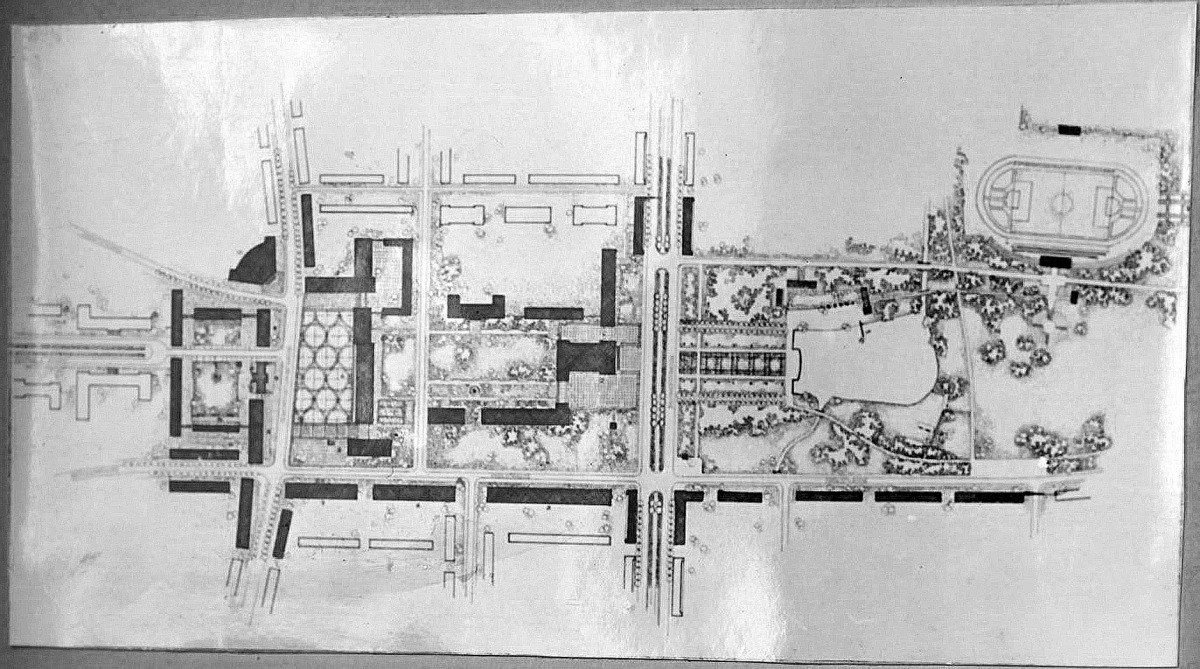
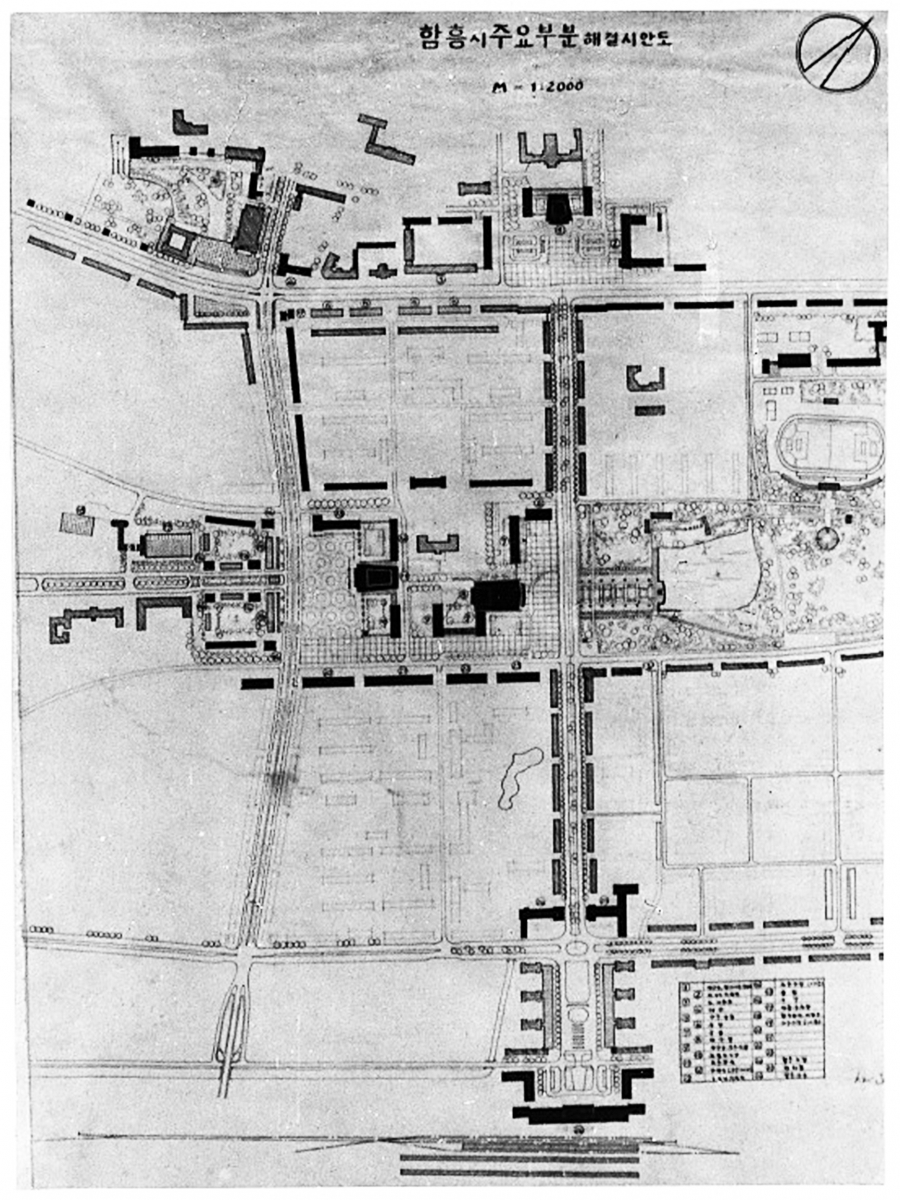
Stiftung Bauhaus Dessau / © (Püschel, Konrad)
(bottom) ‘Comprehensive Construction Plan of the City of Hamhung’, planned by Karl Sommerer in 1959
©Bundesarchiv Berlin / Signiture: D20
From a Central Square to a Symbolic Space
However, the Central Square of Hamhung has a quite different look compared to both Püschel’s and Sommerer’s proposal. It does not look like a type of Group Square that is built out of a combination of multiple buildings. There exists a huge symbolic space around the large-scale building of the Hamhung Grand Theatre (1984). The Symbolic Square is distinguished from the Group Square in terms of whether it has a certain direction. In other words, the latter features an unclear direction at the front or back side, even if one might sense its directionality, whereas, the Symbolic Square structured by the symbolic buildings has a distinct front face. For instance, the front of Gwanghwamun Square is in the direction of Gwanghwamun, and the front side of Kim Il Sung Square is in the direction of the Grand People’s Study House. Which direction will the Theatre take? In fact, it is not easy to discern the front of the Hamhung Grand Theatre by looking at the site plan or satellite photos. Due to its unusual shape and the fact that squares are on both sides of the building, as well as its urban axis stretching towards the Songchon River, the front of the Hamhung Grand Theatre is often assumed to be that facing the Songchon River. In fact, the actual front of the Hamhung Grand Theatre is on the opposite side, facing towards Hamhung Youth Park. This supposition is backed by both the location of the Kim Il Sung Immortality Tower in Hamhung Youth Park, and the typical approach to forming symbolic space in North Korea. The Central Square of Hamhung was built in the 1980s when the construction of Hamhung Grand Theatre and Kim Il Sung Immortality Tower was completed. In relation to this, let’s look at the symbolic space (central space) of Pyongyang. Designed as the city’s central space in their post-war reconstruction plan, the Kim Il Sung Square in Pyongyang acquires the symbolism of both ‘people’ and ‘leader’ at once, as Grand People’s Study House and Juche Tower are built in the 1980s on the opposite side. This type of square configuration is found in Hamhung, where Hamhung Grand Theatre as a cultural facility for ‘people’ and the Immortality Tower signifying the ‘leader’ is contributing greatly to the formation of space. In other words, the Central Square that Püschel and Sommerer proposed has been transformed into a Symbolic space.
If Püschel and Sommerer were to see the current state of Hamhung, they might be disappointed. Their proposal intended to establish the urban axis, restoring its function as a city, to attain a modern appearance, and to promote the expansion of city along this axis. However, the current state of Hamhung is far from realising such ideas. For instance, in
Sommerer’s ‘Comprehensive Construction Plan of the City of Hamhung’, the urban axis is set in front of the Hamhung Station, meeting perpendicular to Jongsong street. In order to embrace this axis, there are green zones planned on the side of Jongsong street, between the new government building and the street. Although the trail leading to this street in front of the station can be found in present day Hamhung, the level of its importance became much lower than that of the Square in front of the Hamhung Grand Theatre.
These changes have been predicted due to the difference in views between DAG, who had already been there in the early stages of reconstruction, and North Korean engineers. In his 1958 letter, Püschel severely criticised North Korean engineers for misunderstanding the city plan, claiming that they were only interested in monumental architecture instead of a socialist city with a more generous jobhousing proximity.▼10 Eventually, after DAG withdrew in 1959, the conflicts in understanding and perspectives on urban functions impacted the spatial design of Hamhung. For instance, the statues of Kim Il Sung and Kim Jung Il now stand in Hamhung Tonghungsan. As this is the same in Mansudae in Pyongyang, this reflects the symbolic significance of a leader looking down on the city from a great height. While the South Hamgyong House of Culture, completed in 1960, was designed by DAG with its architectural style to follow that of the Bauhaus, it is unclear whether it still functions as the element that will receive the urban axis, which can be found in the ‘Comprehensive Construction Plan of the City of Hamhung’.
The Terminus of the Bauhaus Brigade: The Korean Peninsula
Although an architect from the Bauhaus took the lead in city planning, it might be an exaggeration to say Hamhung is a ‘city of the Bauhaus’. Yet, the traces of Bauhaus remain threaded throughout the city grounds, with many instances to perceive in the streets, on buildings, or in the location of buildings. There may be someone who wishes Hamhung could have remained closer to the ideals of Bauhaus, but if that had been the case, could we have been able to read aspects of North Korean society from Hamhung? The city becomes interesting through a number of small physical clues that help us to read what will happen during a certain time period and presumes the characteristics of the society. This may be why we feel excited about Hamhung.
There are various exhibitions ongoing to celebrate the Bauhaus centennial. Of them, an exhibition entitled ‘Bauhaus Imaginista’ has been taking place around the world since 2016, where many curators and researchers get together and track the trends of the Bauhaus. The story of Hamhung is a source that will never be missed here. The Korean Peninsula, specifically Hamhung, holds an important position for researchers of the world following the Bauhaus. This is not based on a nationalistic point of view, claiming the Bauhaus as part of our architectural history. The Korean Peninsula, which is recognised as the Far East to Europeans, may be the terminus of the Bauhaus Brigade. To Korean architects, this leaves tasks remaining of how to understand this trend as part of our history and how to expand it into broader architectural discourse.
1. Rosemary Foot, Substitute for Victory: The Politics of Peacemaking at the Korean Armistice Talks (Ithaca: Cornell University Press, 1990), pp. 207 – 208.
2. 1 Million Rubles at that time equals to approximately 2.6 million USD, 3 billion KRW
at today’s currency rates. (Based on Historicalstatistics.org)
3. SSSR i Koreia (Moscow: USSR Academy of Sciences, 1988), p. 256.
4. Cited in Rüdiger Frank, Die DDR und Nordkorea - Der Wiederaufbau der Stadt Hamhùng von 1954 – 1962 (Berichte aus der Politik)
5. Charles K. Armstrong, Tyranny of the Weak: North Korea and the World, 1950 – 1992 (Ithaca, London: Cornell University Press, 2017), p. 74.
6. Konrad Püschel, Wege eines Bauhäuslers: Erinnerungen und Ansichten, (Dessau: Anhaltische Verlagsgesellschaft mbH)
7. Hideo Tomita, “Wohnkomplex in the 1930s USSR and 1950s North Korea by an East German Architect”, Proceedings of 11th International Symposium on Architectural Interchanges in Asia, September 2016, Tohoku University, pp. 2288 – 2292.
8. Charles K. Armstrong, Tyranny of the Weak: North Korea and the World, 1950 – 1992 (Ithaca, London: Cornell University Press, 2017).
9. Paul Zucker, Town and Square: From the Agora to the Village Green Pp. Xxiii. 287. Pl. 96. (New York: Columbia University Press, 1959).
10. Letter from Konrad Püschel, 30 June 1958. Bauhaus Archives, Dessau. 22/58/15.
degree in Urban Design Architecture from Harvard University. He is principal of
PRAUD and the professor in the Graduate School of Architecture and Urban Design. Yim Dongwoo was awarded the Architectural League Prize 2013, and was a participant architect of the Golden Lion winning Korean Pavilion at the 2014 Venice Biennale. At the Seoul Biennale of Architecture and Urbanism 2017, he was director of ‘Pyongyang Salim’, and now participates as a curator in the 2019 Seoul Biennale of Architecture and Urbanism.





